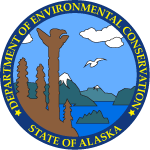| 10/29/1992 |
Document, Report, or Work plan Review - other |
Staff provided comments to Jane Smith on the Remedial Action Report for Site 1: Charlie Row and Site 2 Connex near Building 47431 (Hangar 4) dated September 21, 1992. The connex site will be addressed at a later time pending comments from U.S. EPA Region 10 and ADEC SCRO RCRA hazardous waste management section. Staff requested clarification on matrix score sheet item 4 Potential Receptors since the nearest well is 4,800 feet away but does not state if it is a drinking water well or a monitoring well. Staff requested corrective action plan for the soil above the 1,000 mg/kg DRO cleanup level found below the asphalt strip adjacent to the excavation.
Staff requested a stockpiling plan be submitted for review for soils to be stored at the stockpile area (UST stockpiles Fort Rich Landfill) for future remediation. ADEC cannot accept composite sampling as a means to determine that a site is "clean". Collection and analyses of the soil samples to verify that a site meets cleanup requirements established under ADEC regulations must be discrete grab samples. All soil samples must be collected in accordance with a submitted sampling plan and must be appropriate to the proposed analytical methods and QA/QC procedures. |
Louis Howard |
| 4/6/1993 |
Update or Other Action |
ADEC received a December 15, 1992 Revision to the Bryant Army Airfield Site 1 Charlie Row and Site 2 Connex near Building 47431 (Hangar 4) Remedial Action Report September 28, 1992. Diesel was detected in 15 of 22 sampling events from 60 mg/kg to 4,400 mg/kg. Most samples were below 340 mg/kg and one sample was at 4,400 mg/kg. Residual range organics were detected in 40 out of 40 sampling events. Contamination ranged from 36 mg/kg to 3,800 mg/kg. Most samples were below 550 mg/kg and 3 samples were higher at 1,500, 3,500 and 3,800 mg/kg RRO.
Summary: Contamination present is diesel range hydrocarbons resulting from aircraft refueling operations. Recommended action is to excavate the areas of heaviest contamination, sample and test the bottom of the excavation to ensure reaching the matrix cleanup level of 1,000 mg/kg DRO. Test methods will be 8100M for diesel and 8015M for GRO as a precautionary since JP4 does have lighter fractions and 8020 to verify no BTEX. |
Louis Howard |
| 1/14/1998 |
Site Closure Approved |
Staff reviewed data submitted that showed confirmational sampling at the site met cleanup criteria Level "C". No further remedial action required - site closed out. Decision document signed by the 3 CERCLA RPMs documenting no further action under CERCLA required and no further action is required under SFRERA either. However, site is still subject to U.S. EPA RCRA closure due to improper storage of drums at site.
The following policy applies for soil regulated under 18 AAC 75 and 18 AAC 78 that is proposed for disposal off site from where it was generated. If the following criteria is met, ADEC approval and/or an institutional control(s) are not required:
1. The soil meets the most stringent Method Two, Migration to Groundwater, Table B2 cleanup level, and the most stringent standards for those chemicals under Table B1;
2. The soil may only be disposed of at any non-environmentally sensitive location in the Under 40" or Over 40" annual precipitation zone;
3. The soil is not placed within 100 feet of water wells, surface waters, and drainage ditches; and
4.The written approval from the landowner of the off-site location is required.
The off site disposal of all other soil subject to the site cleanup rules that does not meet the criteria above shall be reviewed by the ADEC project manager in order to determine if the off-site disposal action poses a current or future risk to human health or the environment. The final approval to dispose of soil off site that does not meet the criteria shall be made by the ADEC Section Manager.
Terms used in this document have the meaning given in 18 AAC 75.990 including: “environmentally sensitive area” means a geographic area that, in the department's determination, is especially sensitive to change or alteration, including:
(A) an area of unique, scarce, fragile, or vulnerable natural habitat;
(B) an area of high natural productivity or essential habitat for living organisms;
(C) an area of unique geologic or topographic significance that is susceptible to a discharge;
(D) an area needed to protect, maintain, or replenish land or resources, including floodplains, aquifer recharge areas, beaches, and offshore sand deposits;
(E) a state or federal critical habitat, refuge, park, wilderness area, or other designated park, refuge, or preserve; and
(F) an area that merits special attention as defined at 6 AAC 80.170 (Repealed see AS 46.40.210(1))
“area which merits special attention” means a delineated geographic area within the coastal area which is sensitive to change or alteration and which, because of plans or commitments or because a claim on the resources within the area delineated would preclude subsequent use of the resources to a conflicting or incompatible use, warrants special management attention, or which, because of its value to the general public, should be identified for current or future planning, protection, or acquisition; these areas, subject to council definition of criteria for their identification, include:
(A) areas of unique, scarce, fragile or vulnerable natural habitat, cultural value, historical significance, or scenic importance;
(B) areas of high natural productivity or essential habitat for living resources;
(C) areas of substantial recreational value or opportunity;
(D) areas where development of facilities is dependent upon the utilization of, or access to, coastal water;
(E) areas of unique geologic or topographic significance which are susceptible to industrial or commercial development;
(F) areas of significant hazard due to storms, slides, floods, erosion, or settlement; and
(G) areas needed to protect, maintain, or replenish coastal land or resources, including coastal flood plains, aquifer recharge areas, beaches, and offshore sand deposits. |
Louis Howard |




